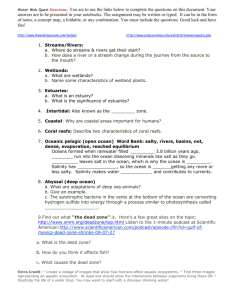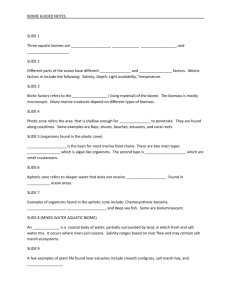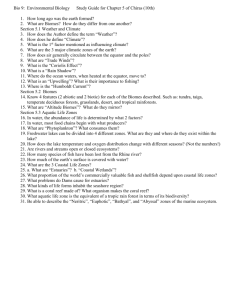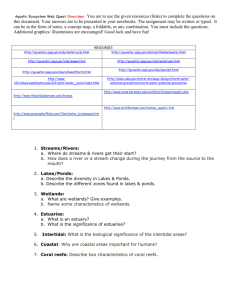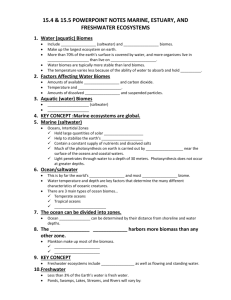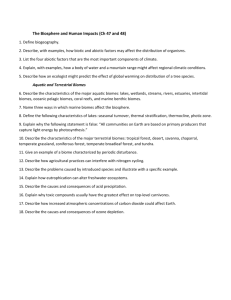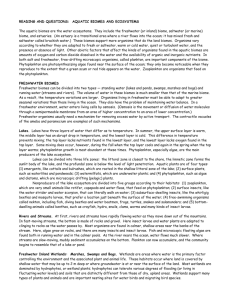47.3 Notes
advertisement
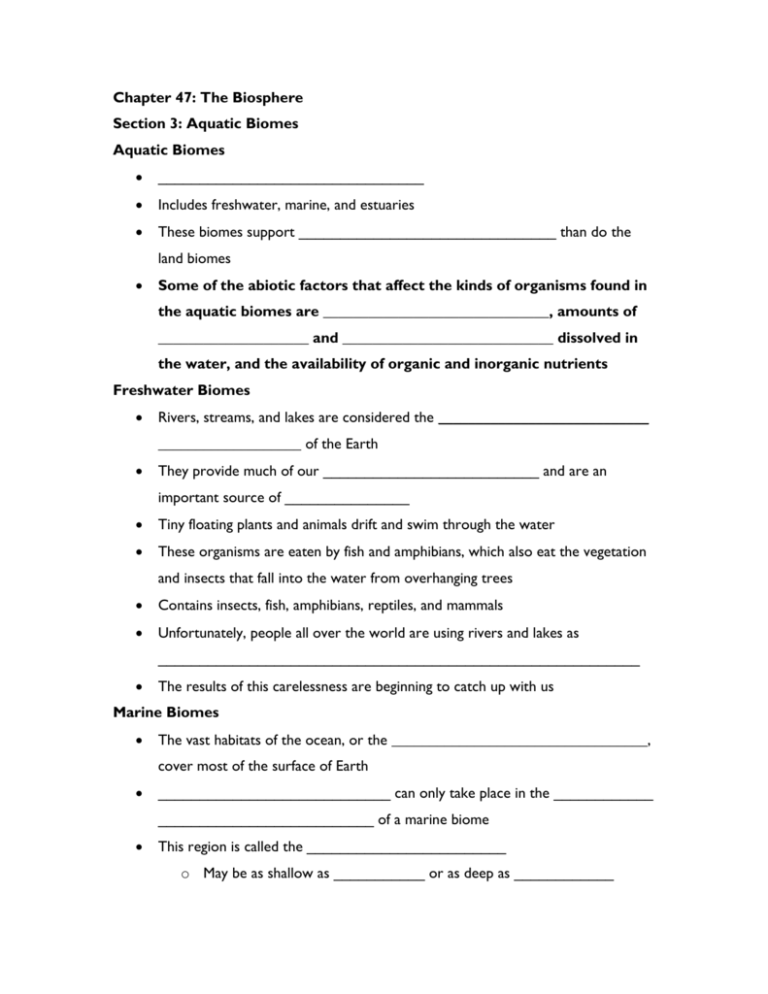
Chapter 47: The Biosphere Section 3: Aquatic Biomes Aquatic Biomes ________________________________ Includes freshwater, marine, and estuaries These biomes support _______________________________ than do the land biomes Some of the abiotic factors that affect the kinds of organisms found in the aquatic biomes are ______________________________, amounts of ____________________ and ____________________________ dissolved in the water, and the availability of organic and inorganic nutrients Freshwater Biomes Rivers, streams, and lakes are considered the ____________________________ ___________________ of the Earth They provide much of our __________________________ and are an important source of _______________ Tiny floating plants and animals drift and swim through the water These organisms are eaten by fish and amphibians, which also eat the vegetation and insects that fall into the water from overhanging trees Contains insects, fish, amphibians, reptiles, and mammals Unfortunately, people all over the world are using rivers and lakes as __________________________________________________________ The results of this carelessness are beginning to catch up with us Marine Biomes The vast habitats of the ocean, or the __________________________________, cover most of the surface of Earth ____________________________ can only take place in the ____________ __________________________ of a marine biome This region is called the ________________________ o May be as shallow as ___________ or as deep as ____________ o _________________________________ grow here Oceanographers have divided marine biomes into distinct zones based on their depth and distance from the shore Each of these zones contains organisms that are adapted to the conditions there Intertidal Zone ___________________________________________________________ ____________________________ Must tolerate radical changes in their surroundings o Once or twice a day they are ____________________ in ocean water o The remainder of the time they are exposed to __________________ _______________________ o Organisms here have adapted in some way to the pounding and crashing of ________________ o Some organisms __________________ into the sand to keep from being washed out to sea o Other attach themselves to ________________ Neritic Zone Extends from the low-tide line to the edge of the open sea ______________________________________________ because this part of the ocean is the photic zone In shallow areas of tropical waters, meadows of turtle grass provide food for fish, invertebrates, and turtles Along the ocean floor, ________________________________ crawl while _____________________________ swim above them Open-Sea Zone Phytoplankton are responsible for ________________ of the Earth’s photosynthetic activity Phytoplankton are eaten by ______________________________ Thus the chain of life in the sea begins with these tiny organisms Swimming rapidly through the open-sea zone are fish of all shapes and sizes and mammals such as dolphins and whales Because nutrients are scarce in most of the open sea, the growth of phytoplankton is ____________________________ This __________________ the number of animals that can live there Closer to the shore, however, nutrients are more abundant, and countless fish swim there to ________________________________ Unfortunately, these rich fishing areas are much more susceptible to _____________________ than is the open sea Deep-Sea Zone Area of high pressure, cold temperature, and total darkness This area is home to some of Earth’s ________________________________ Here, zooplankton wait for night in order to migrate to the ocean’s surface and feed on phytoplankton Herds of _____________________________ crawl along on the ocean floor Estuaries ____________________________ are found at the boundary between fresh water and salt water Salt marshes, mangrove swamps, lagoons, and the mouths of rivers that empty into the ocean are examples of estuaries Estuaries support a variety of life forms Because estuaries are usually shallow, ____________________ is able to penetrate the water completely __________________________ occurs at all levels, making estuaries a suitable environment for aquatic plants The abundance of such plants, in turn, supports many types of _____________ ________________________________ In fact, many fish and invertebrates spawn, hatch, and nurse their young in estuaries As the young mature, they head for _______________________, then return to the estuaries to reproduce Several species of birds use estuaries for _____________________________ ____________________________
